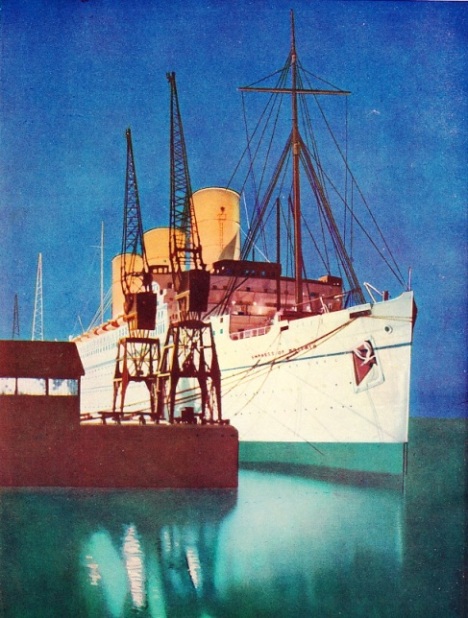

© Shipping Wonders of the World 2012-

R.M.S. “Empress of Britain”
Outstanding as an engineering achievement and for the beauty of her lines, the Canadian Pacific Fleet’s flagship which links Great Britain with Canada is one of the finest modern luxury liners
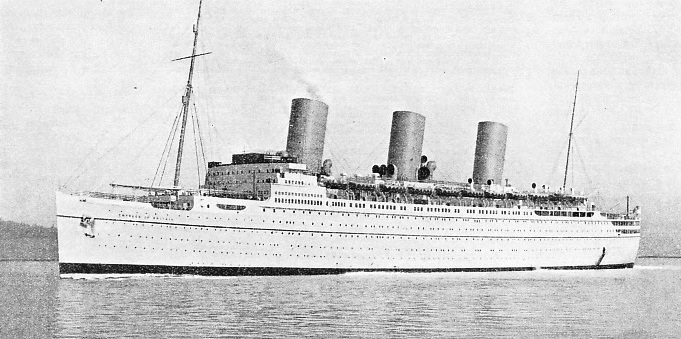
READY FOR SEA. The Empress of Britain provides a splendid example of the powerful appearance of the modern transatlantic liner. With an overall length of 760 ft 6-
THE flagship of the Canadian Pacific’s Atlantic fleet, the Empress of Britain, was built by John Brown and Company, and launched by H.R.H. the Prince of Wales on June 11, 1930.
Viewed from the waterside, the huge ship presents a wonderful picture, reminiscent of a great walled city, gleaming white and surmounted by the triple towers of her giant funnels and by the two steel masts which lift gracefully skywards.
For speed and safety, comfort of accommodation and excellence of technical equipment the Empress of Britain is a wonderful testimony to the skill of the British shipbuilder. Her building, launching and fitting out can be but briefly touched on here, since the methods employed in the great shipyards are described elsewhere in this work. The ship has been built to conform to the requirements of Lloyd’s Register of Shipping under that society’s highest class -
There are ten decks, one of the most important being the promenade deck, 648 feet long.
Above the promenade deck is the boat deck, 396 feet long at the sides of the ship; above this is the sports deck, 455 feet long. On top of the sports deck is yet another, known as the sun deck, 192 feet long, from which rise the tops of the funnel casings, ventilators and other portions of the vessel’s superstructure.
ILLUMINATED BY FLOODLIGHTS, the distinctive appearance of the Empress of Britain is emphasized. She is a Canadian Pacific liner with a gross tonnage of 42,348. One of the world’s largest ships, she has an overall length of 760 ft 6 in and a moulded beam of 97 ft 6 in. Her moulded depth to the top of her sun deck is 100 ft 6 in. She was built in the same yard as the Queen Mary and was launched by H M King Edward VIII (then HRH the Prince of Wales) on June 11, 1930.
Below the promenade deck and running full length of the ship is the first of a series of decks, within the hull, lettered from A to G. The two lowest decks, F and G, do not extend the entire length of the ship, but only forward of and abaft the machinery space. The whole of the steel plating below the water line is doubled, the distances between inner and outer plates or skins varying from 4 feet at the sides to just over 5 feet in way of the centre line. Between the inner and outer plating, subdivided into forty-
An interesting feature of the hull construction is the doubling of the forward water-
The principal dimensions of the vessel are: length overall 760 ft 6-
Although every effort has been made to reduce weight by the use of special steels, the hull is of remarkably strong construction. The flat plate keel comprises two layers of steel-
Between A Deck and the promenade deck the side plating is doubled. The total weight of steel in the hull alone is over 19,000 tons. Some of the steel used takes the form of huge steel castings, such as those for the stern post, carrying the rudder, the brackets that support the propeller shafts, and part of the stem. The stern post and shaft castings, together, weigh about 130 tons.
The Empress of Britain has a cruiser type of stern, but an ordinary straight stem. The stem is a rolled steel bar carried up from a casting at the forefoot. The enormous rudder and stock comprise steel forgings, weighing 65 tons, covered on either side with steel plating. The rudder forging, built up in Darlington, Co. Durham, was transported on a special sixteen-
Watertight and Fireproof Doors
One of the most important factors governing safety at sea is the subdivision of ships by means of watertight bulkheads. In the Empress of Britain this subdivision is effected by fourteen transverse bulkheads extending up to D Deck. The inner sides of the engine and boiler-
The bulkheads are pierced by large openings that can be closed by watertight doors. There are twenty-
An alarm signal at each door gives warning when it is about to be shut, and electric light indicators in the chart-
Above D Deck, where the watertight bulkheads terminate, the whole ship is subdivided by fireproof bulkheads provided with fire-
In all corridors and at vital points are placed chemical extinguishers for hand use. There are also numerous hydrants for the supply of water from special pumps to fire hoses.
Ample warning of fire or other emergency is given to passengers and crew by a system of fifty-
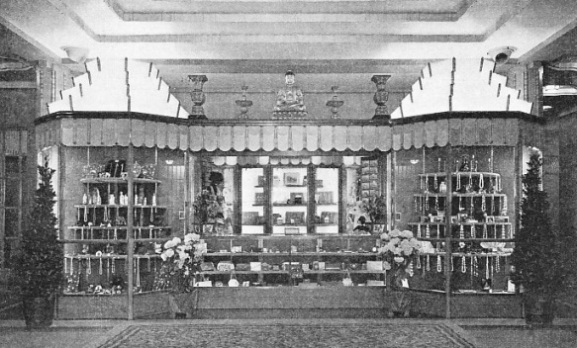
SOUVENIRS OF A VOYAGE in the Empress of Britain may be bought from a shop on the first-
In addition the cargo holds are protected against fire by means of a special smoke-
A remarkable range of life-
The most important item in the life-
In addition to this fleet there are two 30-
Wireless at sea is used for many purposes other than life-
Aids to Navigation
The Empress of Britain is equipped with up-
The navigation lights and the masthead lights are all electric, connected with a special electric indicator that shows whether they are satisfactorily illuminated. Should a light fail, the corresponding indicator light goes out and an electric bell warns the officer of the watch that a failure requires attention. The importance of the look-
The steering-
Instead of the rowing boat’s steering ropes, however, there are four large cylinders opposed in pairs on either side of the rudder stock. Each cylinder contains a steel ram attached to the tiller head. Oil is pumped into the cylinders to move the rams and so turn the rudder as required.
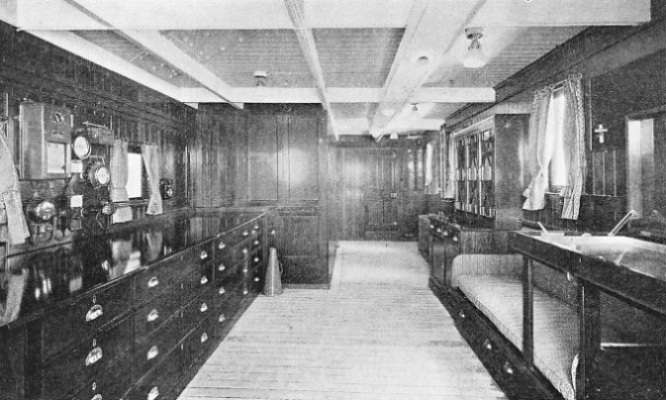
THE CONTROL CENTRE of the Empress of Britain, comprises the chart-
The oil pumps are operated by two 160-
The steam turbines that drive the four propellers of the Empress of Britain develop 62,500 shp and maintain a normal speed of twenty-
The main turbine sets are wonderfully compact in design, despite their great size. Each comprises a low-
Turbine Gearing
A description of the steam turbine’s action will be found in the chapter “Steam Turbine Engines”. Briefly, however, a turbine consists of a drum or rotor that revolves in a cylindrical casing. To the rotor are attached vanes or blades, spoke-
The dimensions of the turbine gearing of the Empress of Britain give some indication of the immense size of her machinery. The main gear wheel of each inboard engine is 14 ft 6-
Exhaust steam from the turbines is led to the condensers that form an integral part of each engine unit. The ordinary marine condenser is essentially a large bank of tubes through which sea water is pumped to cool them. Exhaust steam impinging on the tubes is condensed and used for replenishing the boilers, thus saving fresh water. Another important function of the condenser system is to reduce back pressure in the engines and so to increase power. The turbines are also fitted with special ejectors that keep them free of air.
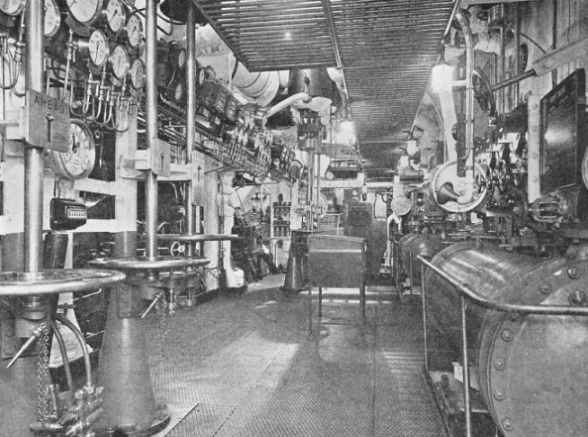
IN THE FORWARD ENGINE-
Each inboard condenser in the Empress of Britain has a cooling surface of 20,700 sq. ft. The surface of each outboard condenser is 9,600 sq. ft. There ire some sixty tons of condenser tubes and fixing ferrules, with a total length of over sixty miles.
The power of the turbines is transmitted to the propellers by four huge steel shafts, leading from the engine-
The propellers are enormous and are cast in solid bronze. Each inboard propeller is 19 ft 3-
The outboard propellers are 14 feet in diameter and turn at 200 revolutions a minute. Each propeller is so perfectly balanced that it can be rotated on a test stand by the pressure of a finger.
Water-
The main steam-
The chapter on “Modern Marine Boiler Types” gives a fuller description of these boilers. The Yarrow type, however, may be briefly explained as comprising a steam drum connected to several water drums by a number of steel tubes. Drums and tubing are enclosed by a casing into which the fuel oil is sprayed and ignited. The Johnson boiler comprises an upper steam drum joined by banks of tubes to a water drum placed beneath it. Each of the Yarrow boilers in the Empress of Britain is approximately 23 feet long. 26 feet high and 26 feet wide. The operation of the oil burners is almost silent and the great sheets of white flame can be viewed through glass windows in the boiler fronts.
Six of these boilers are accommodated in an after boiler-
The whole of the machinery in the ship is so arranged that not a cubic foot of space is wasted. Auxiliary machinery comprises every device for securing efficiency and economy and can be touched on only briefly in this chapter. The auxiliary machinery is in the main electrically operated, taking its current from Diesel-
The requirements of the Empress of Britain for electric light, heating and power are similar to those of a small town. The main generating plant comprises four Diesel-
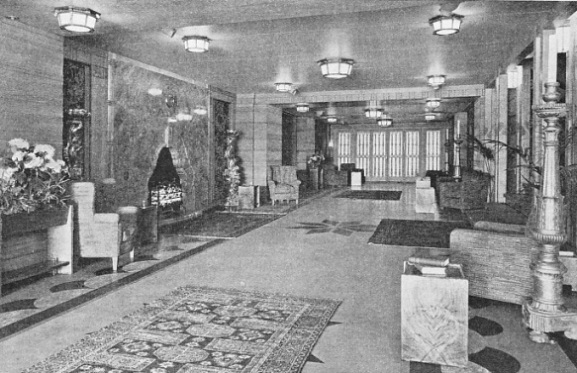
THE TASTEFUL LUXURY is the note struck by the rich appointments of the passengers’ quarters on board the Empress of Britain. The designers of the vessel made it their object to allot each passenger as much space as possible. This illustration shows an exquisitely furnished first-
The demands on the electric supply system of this ship are heavy, for not only are the lighting, heating and cooking dependent on it, but also all the auxiliary machinery. Five passenger lifts and seven other lifts are electrically operated, as are also the winches, deck cranes, fans, laundry and various machinery. There are 407 electric motors in use for different purposes, totalling 5,720 hp.
A thorough tour of the Empress of Britain constitutes much more than an afternoon’s stroll. Many hours would be needed to explore her ten decks and hundreds of passages that involve a walk of many miles. We can therefore touch but briefly on her marvels here.
At the bows on A Deck there are two anchors housed in recesses let into the hull. These weigh, with a third bower anchor, over 27 tons. Aft of these is seen the cargo hatch, with its steel cover that lifts up in the manner of a huge biscuit-
Aft of the foremast and above the promenade and sun decks are the wheel-
Continuing our journey aft, either along the boat deck, or ascending to the sun deck, we pass the middle and aft tunnels and reach, on the sports deck, a full-
The fore and aft diameter of the funnels, oval in section, is 35 feet -
The promenade deck is enclosed for the greater part of its length, the outer sides being pierced for large rectangular windows. On either side of the ship the promenade is 18 feet wide. At the forward end is the ballroom, known as the Empress Room, designed by Sir John Lavery, R.A. It measures 40 feet fore and aft and is 70 feet wide -
Overhead is a great dome, decorated to illustrate the stars as they appeared in the sky on the night of the liner’s launch and illuminated by skilfully concealed lighting. The walls are finished in gold and silver with an underlying tone of blue. The furniture is in blue and beige. At the after end of the ballroom is a stage with coloured footlights.
Adjoining the Empress Room is a cinema projection-
We now find our way aft from the Empress Room along the Mall, a magnificently decorated double gallery, leading on the starboard side through a panelled writing-
Through either of the swing doors in the first-
Of the remaining public rooms the most important is the Salle Jacques Cartier, or first-
Of the other wonders of this ship we can only mention here the Olympian Swimming Pool on F Deck, with its adjacent Turkish baths, cafe and gymnasium. Passenger accommodation includes the extremely comfortable cabins offered the third-
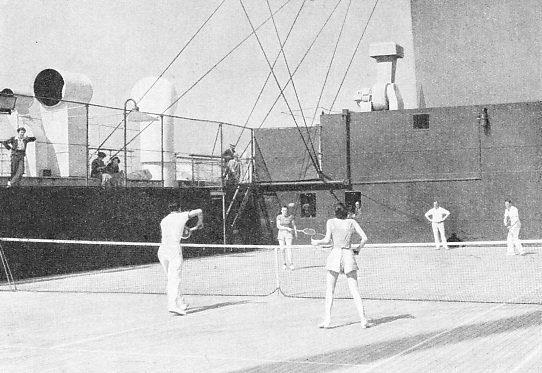
TENNIS ENTHUSIASTS travelling in the Empress of Britain have a full-
You can read more on “British Shipping”, “RMS Queen Mary” and “World’s Largest Ships” on this website.
